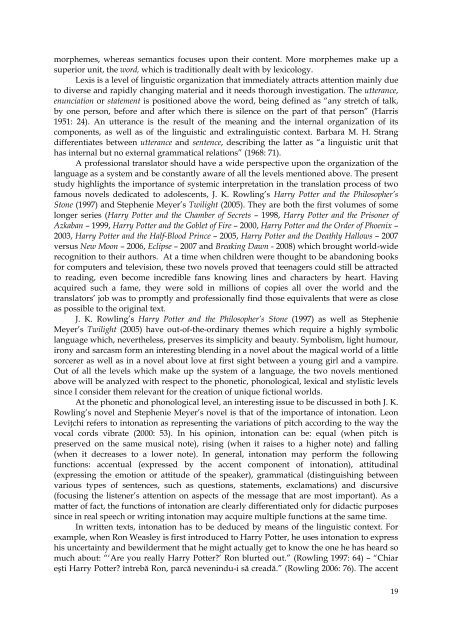Vol. 5/2009 - Facultatea de Litere
Vol. 5/2009 - Facultatea de Litere
Vol. 5/2009 - Facultatea de Litere
Create successful ePaper yourself
Turn your PDF publications into a flip-book with our unique Google optimized e-Paper software.
morphemes, whereas semantics focuses upon their content. More morphemes make up a<br />
superior unit, the word, which is traditionally <strong>de</strong>alt with by lexicology.<br />
Lexis is a level of linguistic organization that immediately attracts attention mainly due<br />
to diverse and rapidly changing material and it needs thorough investigation. The utterance,<br />
enunciation or statement is positioned above the word, being <strong>de</strong>fined as “any stretch of talk,<br />
by one person, before and after which there is silence on the part of that person” (Harris<br />
1951: 24). An utterance is the result of the meaning and the internal organization of its<br />
components, as well as of the linguistic and extralinguistic context. Barbara M. H. Strang<br />
differentiates between utterance and sentence, <strong>de</strong>scribing the latter as “a linguistic unit that<br />
has internal but no external grammatical relations” (1968: 71).<br />
A professional translator should have a wi<strong>de</strong> perspective upon the organization of the<br />
language as a system and be constantly aware of all the levels mentioned above. The present<br />
study highlights the importance of systemic interpretation in the translation process of two<br />
famous novels <strong>de</strong>dicated to adolescents, J. K. Rowling’s Harry Potter and the Philosopher’s<br />
Stone (1997) and Stephenie Meyer’s Twilight (2005). They are both the first volumes of some<br />
longer series (Harry Potter and the Chamber of Secrets – 1998, Harry Potter and the Prisoner of<br />
Azkaban – 1999, Harry Potter and the Goblet of Fire – 2000, Harry Potter and the Or<strong>de</strong>r of Phoenix –<br />
2003, Harry Potter and the Half-Blood Prince – 2005, Harry Potter and the Deathly Hallows – 2007<br />
versus New Moon – 2006, Eclipse – 2007 and Breaking Dawn - 2008) which brought world-wi<strong>de</strong><br />
recognition to their authors. At a time when children were thought to be abandoning books<br />
for computers and television, these two novels proved that teenagers could still be attracted<br />
to reading, even become incredible fans knowing lines and characters by heart. Having<br />
acquired such a fame, they were sold in millions of copies all over the world and the<br />
translators’ job was to promptly and professionally find those equivalents that were as close<br />
as possible to the original text.<br />
J. K. Rowling’s Harry Potter and the Philosopher’s Stone (1997) as well as Stephenie<br />
Meyer’s Twilight (2005) have out-of-the-ordinary themes which require a highly symbolic<br />
language which, nevertheless, preserves its simplicity and beauty. Symbolism, light humour,<br />
irony and sarcasm form an interesting blending in a novel about the magical world of a little<br />
sorcerer as well as in a novel about love at first sight between a young girl and a vampire.<br />
Out of all the levels which make up the system of a language, the two novels mentioned<br />
above will be analyzed with respect to the phonetic, phonological, lexical and stylistic levels<br />
since I consi<strong>de</strong>r them relevant for the creation of unique fictional worlds.<br />
At the phonetic and phonological level, an interesting issue to be discussed in both J. K.<br />
Rowling’s novel and Stephenie Meyer’s novel is that of the importance of intonation. Leon<br />
Leviţchi refers to intonation as representing the variations of pitch according to the way the<br />
vocal cords vibrate (2000: 53). In his opinion, intonation can be: equal (when pitch is<br />
preserved on the same musical note), rising (when it raises to a higher note) and falling<br />
(when it <strong>de</strong>creases to a lower note). In general, intonation may perform the following<br />
functions: accentual (expressed by the accent component of intonation), attitudinal<br />
(expressing the emotion or attitu<strong>de</strong> of the speaker), grammatical (distinguishing between<br />
various types of sentences, such as questions, statements, exclamations) and discursive<br />
(focusing the listener’s attention on aspects of the message that are most important). As a<br />
matter of fact, the functions of intonation are clearly differentiated only for didactic purposes<br />
since in real speech or writing intonation may acquire multiple functions at the same time.<br />
In written texts, intonation has to be <strong>de</strong>duced by means of the linguistic context. For<br />
example, when Ron Weasley is first introduced to Harry Potter, he uses intonation to express<br />
his uncertainty and bewil<strong>de</strong>rment that he might actually get to know the one he has heard so<br />
much about: “‘Are you really Harry Potter?’ Ron blurted out.” (Rowling 1997: 64) – “Chiar<br />
eşti Harry Potter? întrebă Ron, parcă nevenindu-i să creadă.” (Rowling 2006: 76). The accent<br />
19












